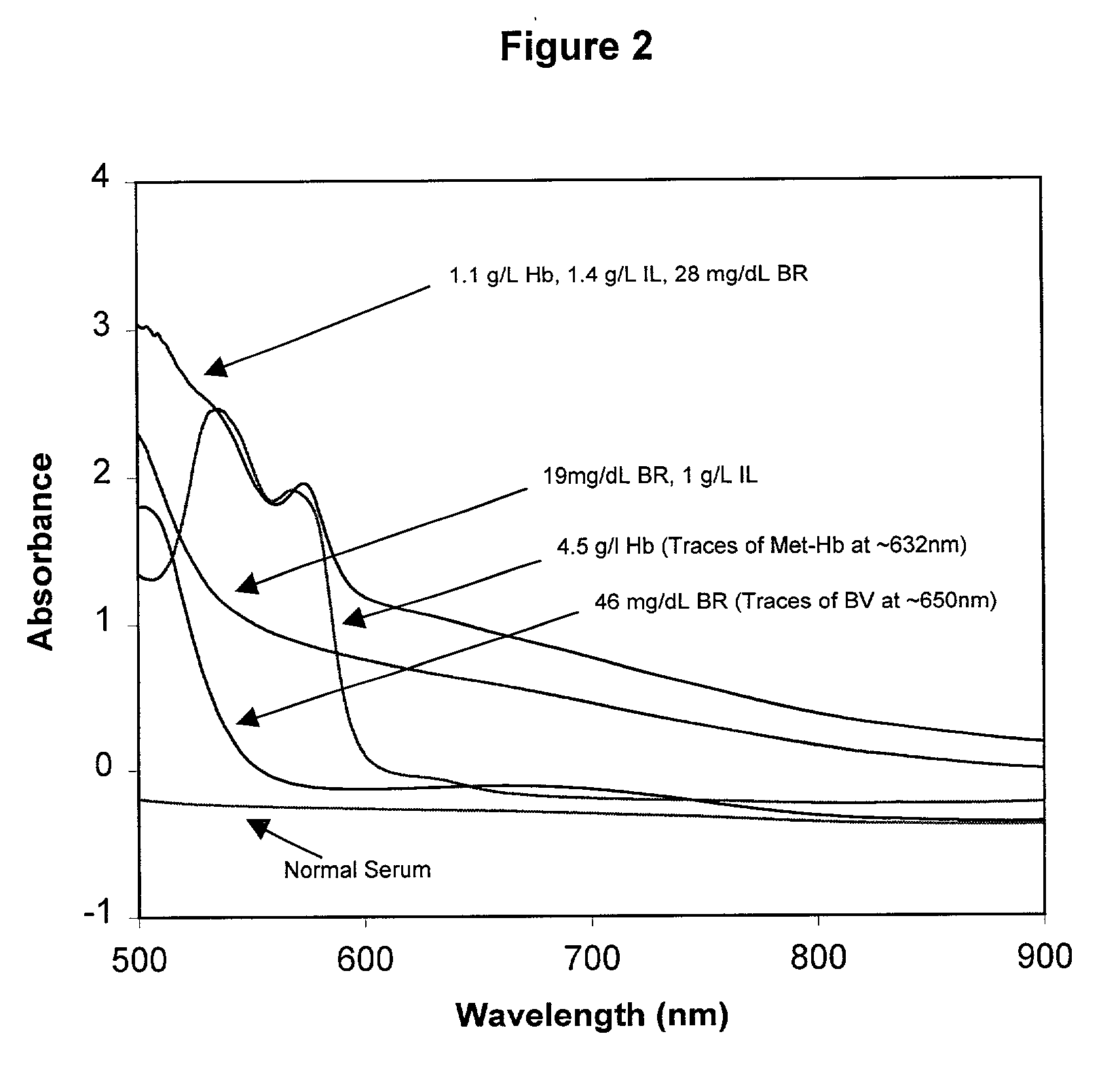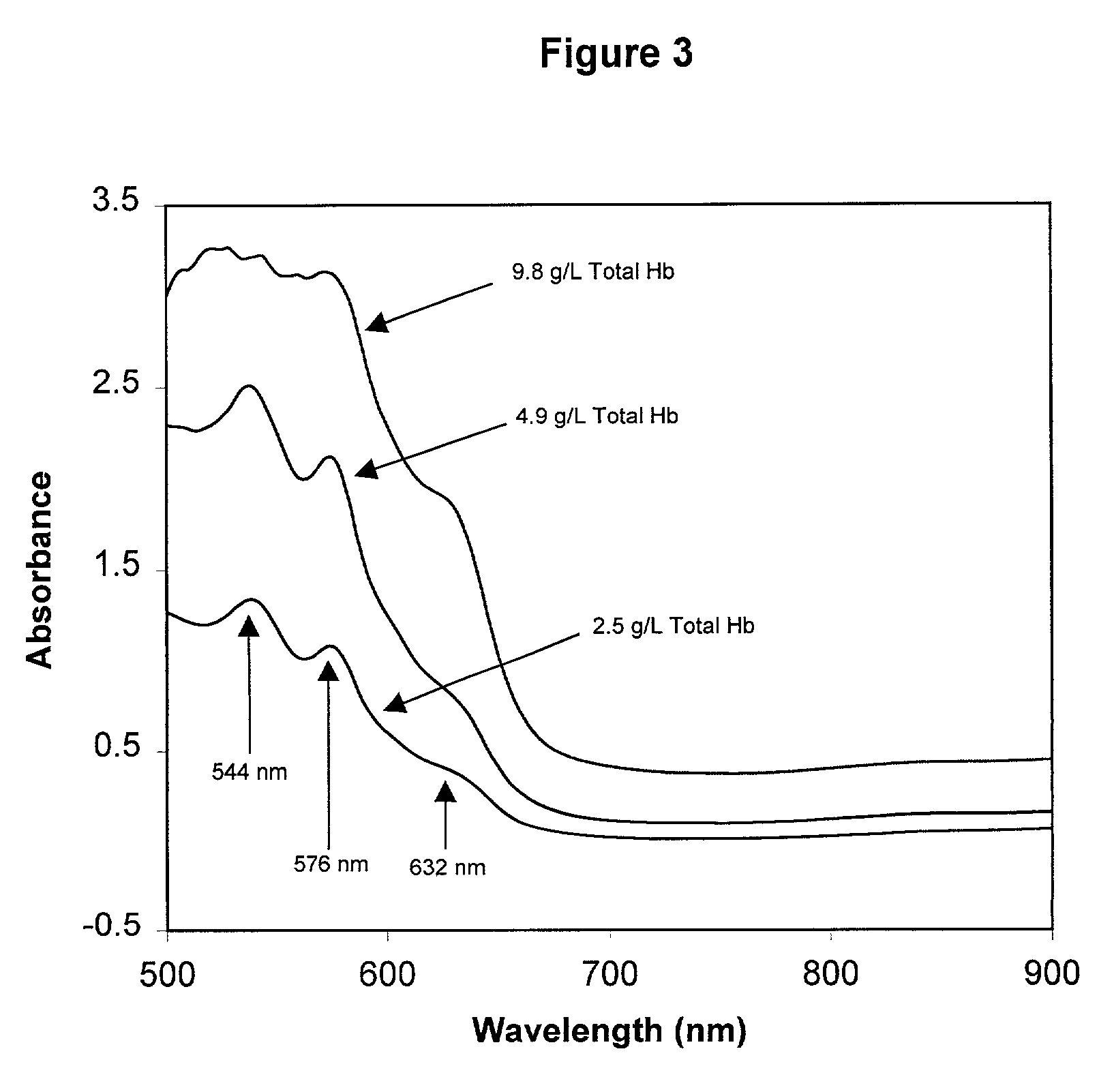Quality control material for reagentless measurement of analytes
a technology of quality control material and reagentless measurement, which is applied in the direction of instruments, chemical methods analysis, material analysis, etc., can solve the problems of no teaching that this method is effective, no reliable method for selecting qcm, and no compromise in sample integrity
- Summary
- Abstract
- Description
- Claims
- Application Information
AI Technical Summary
Problems solved by technology
Method used
Image
Examples
example 1
Hemoglobin
[0268] To prepare a Primary Calibration Algorithm for hemoglobin, sixty serum specimens with no visible interferents were stored refrigerated or frozen until used. More or fewer specimens may be used so long as a sufficient number is used to provide robust algorithm(s). Hb, IL, BR and BV were added to the normal sera to give final concentrations of 0-6.1 g / L, 0-5.1 g / l, 0-42.7 mg / dL, and 0-4.4 mg / dL respectively. Stock Hb was prepared by replacing the plasma (must be free from all interferents) from a blood sample, with twice its volume of water, and lysing the cells through three freeze-thaw cycles. For each cycle the blood was left in the freezer for 45-60 minutes, and then removed and placed on a rocker at room temperature for 30-45 minutes. Hb content of the lysate was measured by a spectrophotometric method for measuring oxy-Hb described by Tietz (Tietz Textbook of Clinical Chemistry, 2.sup.nd Ed, 1994, pp 2022-2025), after removing the RBC debris and unlysed RBC's by...
example 2
Hb-Based Blood Substitutes
[0283] The following is an example of a primary calibration algorithm for Hb-based blood substitute as described in WO 98 / 39634.
[0284] Equation 7 (obtained using disposable polypropylene dispensing tips)
g / L Hb-based blood substitute=23.97(1st D A541)-76.01(1st D A558)+130.84(1st D A600)-113.61(1st D A616)+0.30
[0285] where (1st D A) is the first derivative of the absorbance measurement at the wavelength specified in nanometers.
example 3
Biliverdin
[0286] The following examples of primary calibrations algorithms for biliverdin are described in U.S. Pat. Nos. 6,268,910 B1 and 5,846,492 and WO 97 / 47972.
[0287] Equation 8 (obtained using blood bag tubing)
mg / L BV-45.40(1st D A649)+323.15(1st D A731)-493.79(1st D A907)-1.14
[0288] where (1st D A) is the first derivative of the absorbance measurement at the wavelength specified in nanometers.
[0289] Equation 9 (obtained using disposable plastic dispensing tips)
mg / L BV=98.07(1st D A724 nm)-122.73(1st D A803 nm)+0.07
[0290] where (1st D A) is the first derivative of the absorbance measurement at the wavelength specified in nanometers.
[0291] Equation 10 (obtained using translucent pipette tips)
mg / dL BV=160.29(1st D A718)-206.15(1st D A781)+1.42
[0292] where (1st D A) is the first derivative of the absorbance measurement at the wavelength specified in nanometers.
PUM
| Property | Measurement | Unit |
|---|---|---|
| length | aaaaa | aaaaa |
| wavelengths | aaaaa | aaaaa |
| wavelengths | aaaaa | aaaaa |
Abstract
Description
Claims
Application Information
 Login to View More
Login to View More - R&D
- Intellectual Property
- Life Sciences
- Materials
- Tech Scout
- Unparalleled Data Quality
- Higher Quality Content
- 60% Fewer Hallucinations
Browse by: Latest US Patents, China's latest patents, Technical Efficacy Thesaurus, Application Domain, Technology Topic, Popular Technical Reports.
© 2025 PatSnap. All rights reserved.Legal|Privacy policy|Modern Slavery Act Transparency Statement|Sitemap|About US| Contact US: help@patsnap.com



